
Topics
President Bush has still yet to attend the funeral of a single U.S. soldier killed in action since he took office and his administration is maintaining a ban on journalists filming caskets returning to the U.S. from Iraq and Afghanistan. [Includes transcript]
Click here to read to full transcript On December 21 1989, President George Bush senior was holding a press conference about the US intervention in Panama as the first American fatalities from the conflict were arriving at Dover.
At the beginning of the briefing the president had told reporters he was suffering from neck pain. At the end he did a duck walk to illustrate his stiffness.
Unbeknown to the White House, three major news networks had moved to a split screen. While the president shared his light-hearted moment with the press corps on one half, America’s dead were arriving in caskets on the other. It was a public relations disaster. White House spokesman Marlin Fitzwater described the coverage as “outrageous and unfair” and vowed to express his “extreme dissatisfaction” to the channels concerned.
Less than a year later the White House decreed a ban on traditional military ceremonies and media coverage marking the return of the bodies of US soldiers to Dover. It was an abrupt shift in policy for what had become a national wartime ritual. Along with yellow ribbons and flag waving, the scenes from Dover were part of the American war experience.
For the next 12 years the ban was largely ignored, even after it was extended to all military bases during the last days of the Clinton administration. But this March, shortly before the war began, the Pentagon handed down a directive that made it perfectly clear it expected the policy to be heeded.
- Michael Ratner, president, Center for Constitutional Rights.
TRANSCRIPT
AMY GOODMAN: I wanted to move to another decision of the Bush administration, and ask you about the case. On December 21 1989, President George Bush senior as president was holding a press conference about the US intervention in Panama as the first American fatalities from the conflict were arriving at Dover airbase. With General Manuel Noriega still at large and half of the United States believing the military intervention could not be regarded a success while he remained so, it was a politically sensitive time. At the beginning of the briefing the president had told reporters he was suffering from neck pain. At the end he did a duck walk to illustrate his stiffness. That’s when “the goof-a-meter went off the charts”, as one correspondent put it. Unbeknownst to the White House, three major news networks had moved to a split screen. While the president shared his light-hearted moment with the press corps on one half, America’s dead were arriving in caskets on the other. It was a public relations disaster. The White House spokesman Marlin Fitzwater described the coverage as “outrageous and unfair” and vowed to express his “extreme dissatisfaction” to the channels concerned. Less than a year later the White House decreed a ban on traditional military ceremonies and media coverage marking the return of the bodies of US soldiers to Dover. It was an abrupt shift in policy for what had become a national wartime ritual. Along with yellow ribbons and flag waving, the scenes from Dover were part of the American war experience. For the next 12 years the ban was largely ignored, even after it was extended to all military bases during the last days of the Clinton administration. But this March, shortly before the invasion began, the Pentagon handed down a directive that made it perfectly clear it expected the policy to be heeded. No videotape or photographs of the coffins coming home. Your response to this, Michael Ratner?
MICHAEL RATNER: Well, you understand first of all in 1991, this policy was implemented in the first Iraq war. And it was actually litigated. And it unfortunately was lost. Basically, the court said these are military bases and first amendment doesn’t guarantee you access. But what’s obviously going on here is manipulation of the media. What’s going on here clearly is, they don’t want you to see — the American people to see the dead bodies coming home. And we know that really clearly because if you remember when Johnny Spann was killed, the C.I.A. agent in Afghanistan, his pictures were not forbidden. In fact the military — the U.S. military did a huge event bringing his body back, really to get people angry about the war and to get them into the war in Afghanistan. So, they obviously are using these images to manipulate how the American people feel. Spann’s body gets brought back to Dover. Huge celebration — not a celebration, but a huge event. Other bodies brought back in absolute quiet.
AMY GOODMAN: It’s interesting on Friday morning, on “Morning Edition” on NPR, there was a very moving commentary by a woman who lost her son. She described how when they were in the midst of their grieving at home, the cameras were all there taking pictures of her garage door and front door and she couldn’t stand it. But she said the one public moment was when the body of her son was being brought home. Her whole family turned out in military uniform from the different wars to show their respect that he was a hero. That was the moment that she was willing to share with the world to honor her son. There she was at the hangar with her family. But there were no cameras there, except for a military videographer. She didn’t mention at that point and I assume that she didn’t know, that the cameras cannot be there. She implied her hurt that this was the moment that she would be honored by the world’s spotlight on her son’s casket, but now know pictures. Most people don’t realize this. Most people don’t realize they’re not seeing caskets now. What does it mean to say it was litigated ten years ago. Why then can’t the media go on to Dover air base.
MICHAEL RATNER: Well, it was litigated meaning it was lost ten years ago, that the media lost the court decision. And then the war ended and it was never appealed. The decision was it’s a military base and therefore it’s owned by the government and the government can decide access to that base, and the first amendment rights of all of us out here —
AMY GOODMAN: — if the press made a bigger deal of it?
MICHAEL RATNER: I think — that’s what I was going to say. I think first of all, we’re ready to do another litigation on this and bring together a lot of press people to do it, but I think the litigation itself is not enough. You press has to really be out there objecting. The problem here you read the papers every day and you don’t know the Americans died. What’s the presses interests? The Times puts little squibs in, you know, soldier killed. If they were to a have a big black box every day with the picture of a soldier being killed, that might be different. The press so far has been basically totally tame on this issue and outrageously so. They should be out there really objecting, hopefully if we can get together bring another litigation, we will get a lot of press people barring it.
AMY GOODMAN: Michael Ratner, president of Center for Constitutional Rights. Thank very much for joining us.
MICHAEL RATNER: Thank you, Amy.

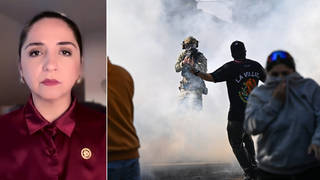
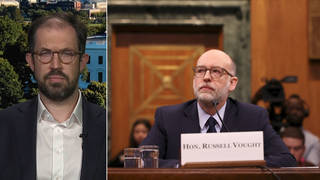
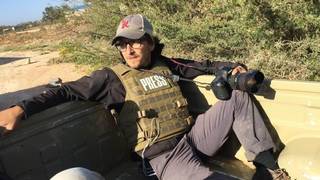
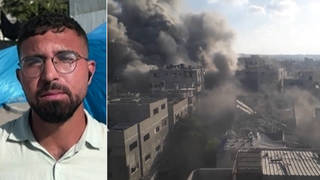





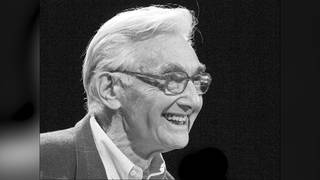
Media Options